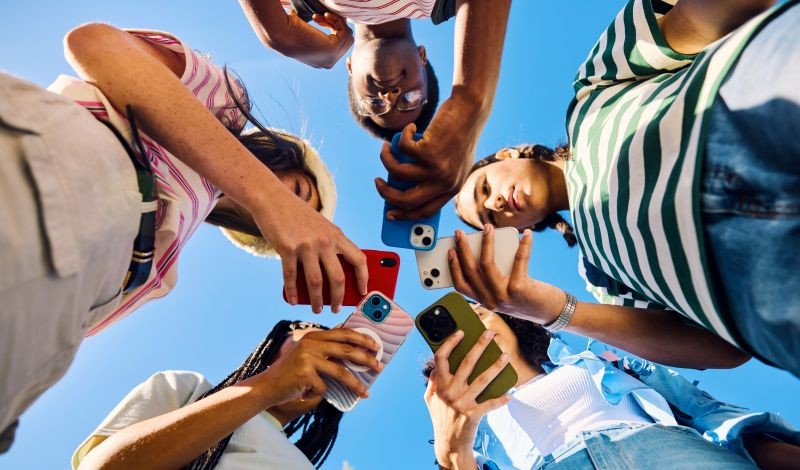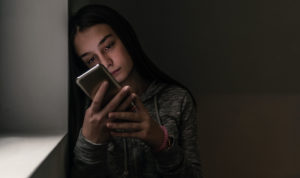
Rampant student smartphone use raises questions about learning goals, online safety, and free speech.
There can be no doubt that social media plays an increasingly significant role in the lives of American students. Yet, the related growth of student smartphone use—granting access to social media—can be problematic.
A 2025 Pew Research Center report revealed that 95 percent of teenagers have access to smartphones, while 88 percent have access to a computer and 70 percent to a tablet. The report also indicated that 96 percent of teenagers say that they use the internet every day, with those who admit to being online “almost constantly” nearly doubling from 24 percent to 46 percent since 2015. An earlier Pew report pointed out that 49 percent of teenagers aged 15 to 17 experienced at least one form of cyberbullying, such as being called an offensive name, having false rumors spread about them, or receiving explicit images they did not ask for.
These reports raise questions about whether access to technology is more of a headache than a panacea for students. In fact, according to a February 2025 study from the National Center for Education Statistics, 53 percent of school leaders believe that cell phones negatively impact students’ academic performance, with 72 percent mentioning the negative impacts of cell phones on students’ mental health and attention spans. Similarly, a 2024 Pew study reported that 72 percent of high-school teachers consider students being distracted by cell phones “a major problem.” Consequently, 74 percent of U.S. adults support banning cellphones during class for middle and high school students.
Social psychologist Jonathan Haidt, author of The Anxious Generation: How the Great Rewiring of Childhood Is Causing an Epidemic of Mental Illness, raises related concerns. In a recent interview, Haidt said that “kids need play and independence if they’re going to become healthy, happy, and independent adults” and that, “when kids move their social lives onto social media like that, it’s not human. It doesn’t help them develop. And right away, mental health collapses.”
Haidt fears that there is growing evidence of an “international epidemic” of mental illness that started around 2012, which was “caused in part by social media and the sudden move to smartphones in the early 2010s” by teens. Haidt also points to “harrowing stories of self-harming behavior and suicide attempts” among children with access to social media.
Another confounding factor relating to smartphones and social media is that student test scores on the latest National Assessment of Educational Progress examination, often called “the Nation’s Report Card” for assessing education outcomes nationally, demonstrated that only 22 percent of high-school seniors were proficient in mathematics, down from 24 percent in 2019. Further, just 35 percent of seniors were proficient in reading, down from 37 percent in 2019. Consequently, Martin West, professor at the Harvard Graduate School of Education and vice-chair of the board that oversees the assessment, argues that, although he does not see a direct, definitive causal link between smartphones and decreased learning, the circumstantial evidence is “sufficiently strong to justify more experimentation with bell-to-bell phone bans in schools.”
Against the background of these growing concerns over student well-being, states are taking steps to limit students’ use of cell phones and access to social media during school days. Thirty-four states and Washington, D.C., now require school boards to develop policies addressing student cell phone use, with what appears to be bipartisan support. These laws and school policies often include exemptions for students with medical needs, with disabilities, facing emergencies, and using school-issued devices.
Because this trend limiting cell phone use and access to social media in schools is at least partially rooted in concerns related to student behavior, academics, safety, and mental health, states have taken a variety of approaches.
For example, Florida’s law limits phone use during the school day, while other states, such as Ohio, have enacted legislation affording school officials more flexibility in designing their own policies. In North Carolina, schools must teach students about social media literacy. In 2024, Indiana enacted a law with bipartisan support that directs each school to implement a policy that “prohibits a student from using a wireless communication device during instructional time; authorizes a teacher to allow a student to use a wireless communication device for educational purposes during instructional time; and permits a student to use a wireless communication device in the event of an emergency or to manage the student’s health care.”
When cell phone use is prohibited in school settings by statute, access to social media also appears to be restricted. At least 12 states have enacted legislation aimed at general underage social media use, according to the National Conference of State Legislatures. For instance, Utah requires individuals under 18 to obtain parental consent in order to access social media platforms. Limiting students’ social media use should not be surprising because, as noted, these platforms can lead to negative online interactions such as bullying.
Although states may generally regulate student use of cell phones and social media at school without violating the First Amendment of the U.S. Constitution, different considerations arise when they regulate student use of cell phones and social media outside of schools. In its first decision on the subject, Mahanoy Area School District v. B.L., the U.S. Supreme Court provided school boards with some guidance on when they may regulate off-campus social media use without violating students’ First Amendment rights.
In Mahanoy, the Court held that Pennsylvania officials violated the First Amendment free-speech rights of a student by punishing the student for Snapchat posts—made off-campus, during the weekend—that contained vulgarity and an obscene gesture. However, the Court suggested that educators can discipline students in narrowly defined contexts, such as when online posts involve severe harassment targeting specific individuals.
As legislators and educators seek to limit student access to social media, it remains to be seen whether they can balance the need to improve student learning and safety while safeguarding students’ First Amendment rights to free expression in and around schools.





